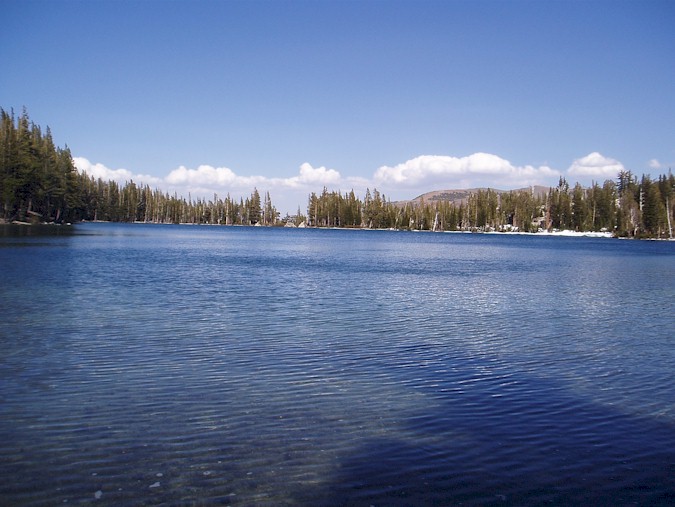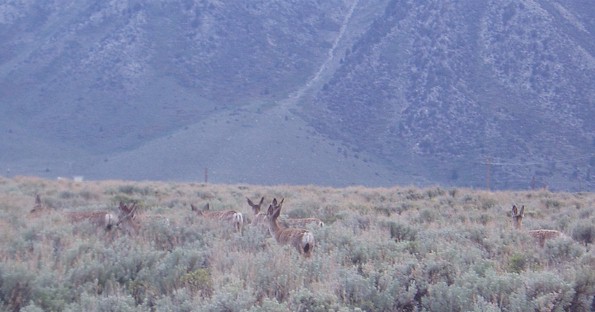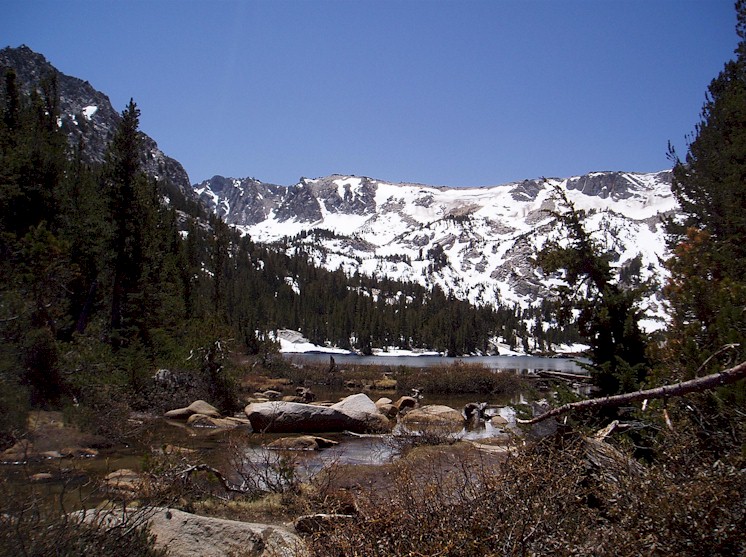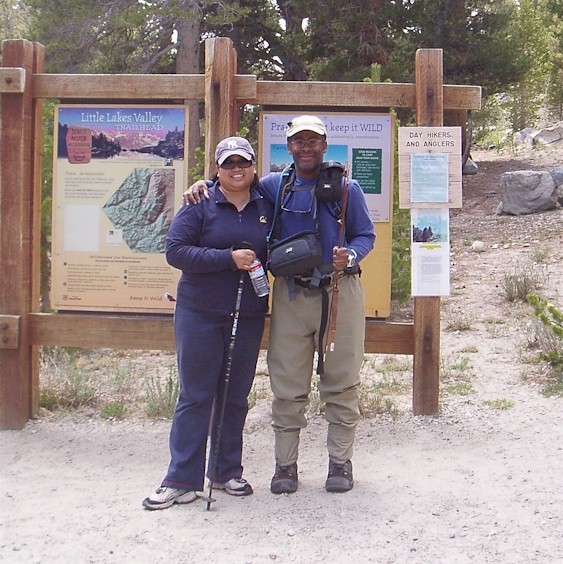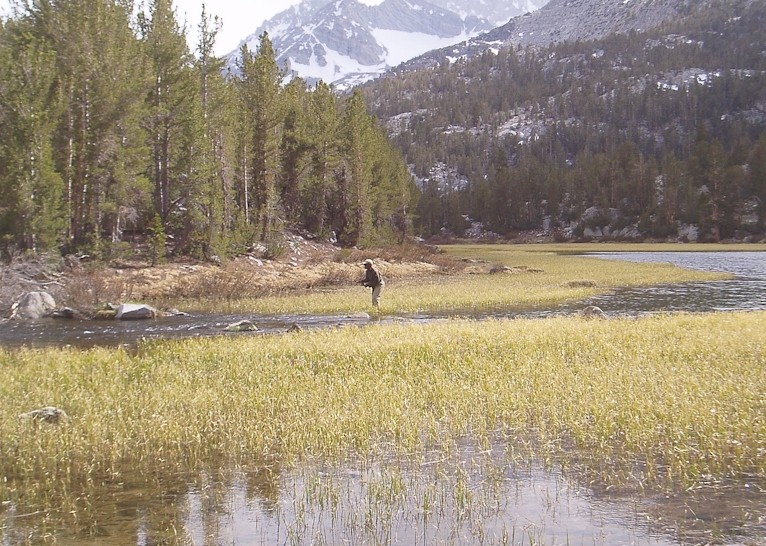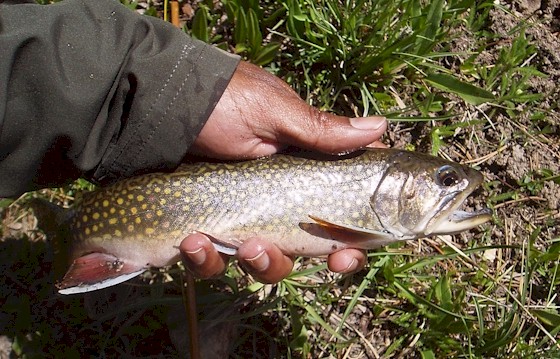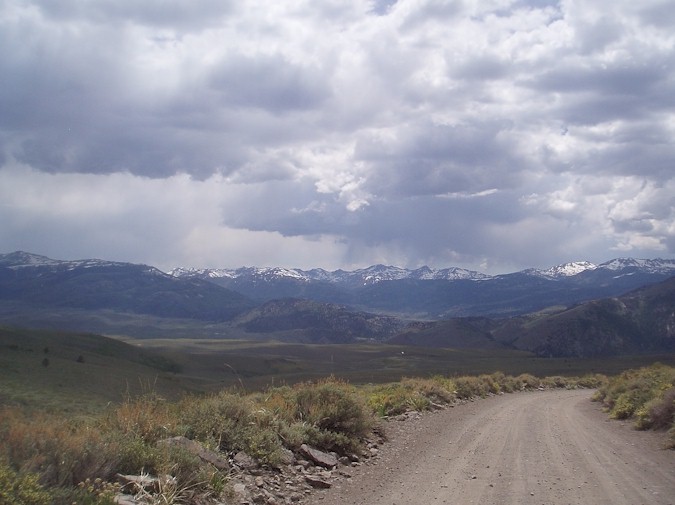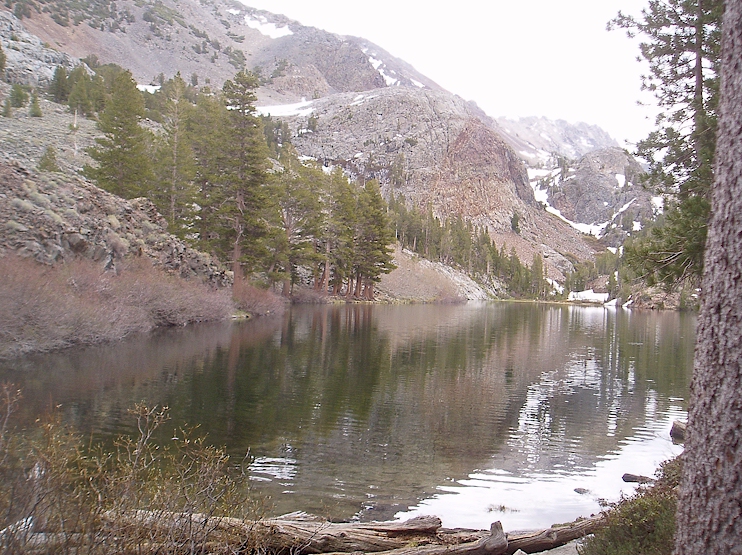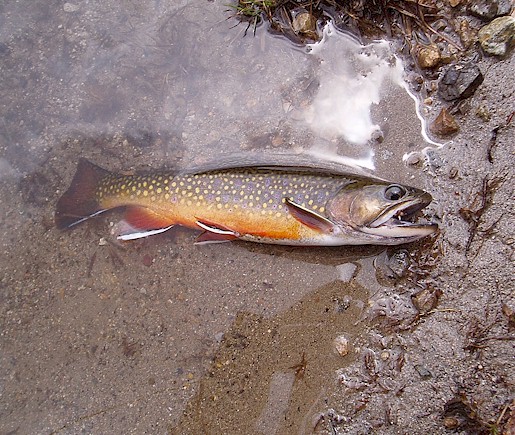|
|
|
|
|
Time:
Early/ Mid afternoon to early evening most days Narrative: Another week in Mammoth Lakes, Ca. has come and gone. After 10 + years youíd think Iíd be bored or find the fishing easy but the Mammoth area has so much water that the challenge one undertakes is only limited to oneís level of fitness and imagination I admit, some years I come to Mammoth feeling a bit cocky, feeling as if I am king of all I survey. This year the fish made sure I started the week with the proper mind set. We arrived late on Saturday May 26 and quickly settled in. I decided to start the week on Sunday by fishing for Lahontan Cutthroat Trout at McCloud (McLeod) Lake. The hike to McCloud from the Horseshoe Lake parking lot is a short 20 minutes when the trail is free of snow. This was the first year in the last three that the road to the upper Mammoth Lakes was open and the trail to McCloud accessible. I quickly noticed how much more crowded the parking lot and trail were compared to the last time I had visited the lake. The lake was crowded as well and Iíd see several new groups of folks on the lake every hour or so.
When I arrived, I quickly made my way to the far side of the lake to fish the cove I was familiar with. The lake was swollen, with snow covered banks on the far shore. A light wind rippled the surface. There was a fellow spin fishing when I arrived. We greeted each other and he informed me that the fishing was poor. I was unconcerned. I could see cruising fish and figured that I had the lake dialed in. Unfortunately, this being my first trip to a high country lake this year, I was a bit too impatient and instead of casting dries to cruising fish, I simply pounded the water. I knew where the fish would be and if they were active, I figured theyíd come to me. It didnít happen. When I came to my senses a few hours later, slowed things down and started presenting my fly to cruising fish, I still couldnít entice any fish. I fished the cove and the far end of the lake on the opposite bank and was joined in late afternoon by abouta half dozen guys who started picking up fish almost immediately. They plopped themselves down within casting distance and started casting away. Suspicious, I asked what they were usingÖ..Powerbait. I nonchalantly gave them a ďdid you know thatís illegal?Ē and fished for an additional 30 minutes before heading over to the inlet. By this time the wind was howling and had changed direction. I made my way to the inlet and the lee shore and practiced casting into the wind for an hour before hiking back to the car. Back at the car I figured I could salvage the day by fishing Hot Creek for an hour or so before dinner. On the way down I contemplated a call to the Department of Fish and Game tip line to report the ďbaitistsĒ but was feeling a bit apathetic. Itís seems that every year Iím reporting a violation somewhere around Mammoth, usually Hot Creek. Itís a bit tiring and I couldnít remember the tip line number (1- 888 - DFG - CALTIP). Ten minutes later I had pulled into the Hot Creek parking lot and was on the phone to DFG. At the end of the day I received a message from the ranger explaining that she was in Mammoth and was heading to the lake. Fishing wise, things didnít get much better at Hot Creek. Iíd been told by a couple at their car that fishing was ďexcellentĒ. I hadnít heard this in a while so I was pretty excited. The river was crowded but I managed to start at the end of my favorite run. The fishing was pretty good but I couldnít manage to hold onto any fish and didnít land a single one. I returned to the condo, smelling of skunk.
Sunday I was determined change things. For several years Iíve wanted to give Crystal Lake a try but Iíve not been able to because of the snow pack. Sierra Trout Guide lists several species of trout as inhabiting the lake- Brown, Brook and Rainbow. I suspected differently. My hike started routinely enough but shortly turned into an adventure. The trail was covered in snow and there were foot prints going every which way. I tried to follow the freshest set of foot prints as those would have been the prints of the two fishermen that had started up the trail before of me but it soon became apparent that they didnít know the way. Some folks ahead of me were turning around and heading back to their cars as the snow grew deeper. I knew the general direction of the lake so I followed my nose. Near the top I met a couple who told me that once I reached the Mammoth Crest, I would be able to see the lake through the trees. Confident that I could find the lake I kept going. Once on the south side of the Crest, the trail became a little more apparent and I followed it until I could see the lake.
My course was true and I soon found myself at the outlet stream. Although most of the stream was covered with snow, it looked like it might be a good creek to fish once it thawed out a bit. The hidden creek reminded me that one has to be suspicious of sudden open terrain when hiking in the snow. Better mountain men than I have taken lethal spills by falling through snow into freezing water. I approached slowly and soon spotted several fish scurrying about. I knew this could be my only chance to catch a fish today so I stopped and rigged up my rod with a size 18 parachute Adams. The tip of my 8ft rod spooked a few fish but I was able to get several nice drifts down the main current. The stream was fairly open and I tried to stay as low and out of sight as possible. I tried several squeeze casts and bow and arrow casts and was less than satisfied with the result. I made a mental note of the deficiencies of the Payne 200 for this sort of work. I need to design a better high country rod. The fish showed zero interest in the Adams so I tried a small midge. No joy there, so I tied on my favorite searching pattern- the caddis cripple. A slight flick and the fly was riding down the main current. The largest fish in the pool swam up to take a look, drifted with the fly a while and then turned away. This was the first of the many refusals I would get on this day and on just about every other day this week. The fish during this trip seemed to scrutinize everything. After another drift or two, the fish finally saw something it liked and I was into my first Golden Trout in 2 years. The fish showed just a hint of hybridization with two small spots below the lateral line. I landed the Golden but had spoiled the pool in the processes. It was time to make my way to the lake proper.
Crystal Lake is situated in a steep rocky basin. The outlet is littered with fallen tree trunks a foot or so high and 10 feet deep. Out of the main current, the logs bob freely. Presumably this peculiar structure or perhaps an underground spring is the cause of the quicksand just behind it. Iíd never experienced quicksand in the Sierra or anywhere else before but as I waded into the water a few feet from shore, I stepped on what looked like firm sand, only to drop to just above my knees. It wasnít the slow sticky drop you get while wading the edges of a meadow stream but was sudden and sobering. Fortunately for me it was only a few feet deep and I waded out easily. At the outlet I waded past several of the floating logs. There was shallow water on the right with a drop off about 15 feet out and directly in front of the outlet. I quickly spotted a couple of cruising fish and cast my cripple caddis to intercept. The first fish rejected the fly instantly and refused to pay attention to further presentations. The first cast to the second fish was apparently outside of itís feeding lane because on the second cast, I lay the fly right on the fishís nose and it was taken without hesitation. Two fish in five minutes; I was hopeful of a good day. There was a spin fisherman on the left bank so I made my way along to the right. The banks were steep and rocky but were easy enough to traverse. On this side of the lake, a drop off roughly followed the shore line. Sometimes this drop would be as far as 10 feet from shore, other times it was immediate. I could see and cast to cruising fish and so was catching fish with some regularity. Unfortunately, I was still getting refusals, especially from the larger trout. I tied on several different dry flies before deciding to check the water for bugs. Novel concept, I know. I picked up several rocks which were void of life and then turned over a rock that had a half dozen large cased caddis. I pealed open a case and found a large, pale yellow turning to orange, worm. October caddis? Iím not sure but it explained why my caddis was getting action. It also explained why it was getting refusals. Right bug, wrong size. Unfortunately, I keep most of my caddis in my other fly box and ironically had decided not to carry with me the dozen size 12 Red Fox Squirrel Hair nymphs I picked up at Sierra Trading Post on Saturday (12 flies for less than $1.00 each. I couldn't pass them up.) The RFSH Nymph would have been the perfect choice. I had some weighed October Caddis nymphs in my box from the Tehipite trip but really didnít want to fish heavily weighted flies. This seems to be another theme for the week- not fishing weighted flies when dries wonít do. I opted for the Sawyer Killer Bug I keep with my high country flies for that 1 in 100 times I come across a scud lake. Ironically, I've been finding more and more caddis lakes recently so I should probably make more room in my fly box.
The fish took the Killer Bug without hesitation and when I didnít miss the strike, I was into fish. When I did miss the strike, wellÖ..I had to move onto a different fish. The fishing was consistent as were the rejections. I canít say I landed a lot of fish in the 4 hours I was at the lake but I sure had my chances and it was fun. In late afternoon the wind picked up and it became all but impossible to see the fish. The fish were there of course but after sight fishing for most of the day, I didn't feel like dragging a fly blindly around the lake. I high tailed it down the mountain and stopped off at Hot Creek. I was serious this time- No LDRs. (I should have a t-shirt made up.) I attacked Hot Creek with an intensity that I havenít displayed there in years. The stream was less crowded than on Sunday owing to the fact that most of the holiday folks were on their way home. It was windy but I didn't let that matter. I managed to land a half dozen or more fish in an hour and didnít lose a single fly to the weeds.
Tuesday wasnít much of a fishing day. The light snow this year allowed my wife, my sister-in-law Megan and me to hike into the Little Lakes Valley in hopes of catching some fish large enough for dinner. I usually donít do this but Megan really wanted some fresh trout for dinner and it seemed the only way I could get the two of them out of town and away from the shopping. The plan was to fish Heart Lake and make our way back to the parking lot, fishing Heart, Marsh and Mack lake and taking a single fish from each. Iíve never had very much luck catching anything but small fish in the LLV and this trip was no exception. Vitaís hiking limit was Marsh Lake so we stopped there. Very shortly I had the largest and only dinner sized fish of the day- an eight inch brown trout. After that it was casting practice and small fish. The wind was up but the fish were still willing to hit a dry fly. Ironically, I spent more time here than at any other any other single piece of water the entire trip.
Wednesday was Grayling day. Sometime shortly before this trip I picked up on the idea of trying to catch a Grayling in the Sierra. After a short internet search I had pinpointed several possible streams and lakes and after a few phone calls I had decided on what I figure is the only reliable stream from which to catch Grayling in California. There was one slight caveat- I needed an SUV. Enter my Dadís X-terra and the promise not to take it any place too ďextremeĒ. I got an early start on the day and found myself at the fly shop in Bridgeport at about 10am. After hunting for local knowledge I was back on the road and making my way up 4x4 track by 11am. A small herd of Mule Deer ran beside the truck as I made my way further and further from the highway. The road was more benign than I had expected and required no daring do until I was at a lake just short of my goal. Breathing a sigh of relief, I thought I was home free once I reached the lake. Iíd negotiated several stream crossings, some steep patches and some sand but nothing I couldnít handle. I hopped out at the lake, took some pictures, ate lunch and hopped back into the truck ready to catch Grayling. Unbeknownst to me, there was a small streamlet to the left of the lake. I hadnít noticed it on my map but if I had, I wouldnít have thought much of it as I was able to ford every stream I had come to. This was different. It was a small tarn and the road had been dug up pretty badly where the streamlet crossed the road. I stopped the car and walked up to the large puddle I'd have to ford. It was only about 10 feet wide but looked to be 15 inches deep. If it had been filled with river rock, no problem but throw in another 6 inches of mud and Iíd seemingly met my match. I wasnít comfortable with the risk of getting stuck, without a winch, 11 miles from the nearest road, on a weekday after a major holiday. The chances of anyone coming by were slim. I weighed my options. My destination was literally on the other side of the lake. I thought about going to the left of the road to avoid the puddle. It looked solid enough but I suspected it was really 15 feet of tire sucking mud. Then there was the right- the side closest to the lake. It was more bog like than on the left but a small mound of solid clay had formed as the rutted road had deepened. The clay wall had tire tracks where someone had used it to bypass the puddle and keep two wheels on firm ground. I decided to do the same and play eco-terrorist. I backed up, put the car in 4 low and barreled over the sage into the bog. The tires spun in the mud and just as the car started to loose momentum, the front wheels came into contact with solid ground and I was up and out. I didnít want to do that again but of course I'd have to on the way out.
I took a quick turn to my right and was soon on an off camber track which paralleled the stream. The quarter mile or so below the lake was fenced so I continued down the trail. The track was extremely rocky and I was probably going a bit too fast as I tried to keep one eye on the stream and the other on the road. The car bucked and pitched wildly. It had never been given such a workout. I short order the road crossed the stream and I decided to park. The stream didnít look very promising; fairly open, low and dusty, I figured it to be too warm to support trout or grayling. I was wrong. I geared up and headed downstream looking for better water. Soon the stream narrowed and the stream side scrub was replaced by willows and fir trees. Iíd found the better water. Immediately I spotted some fish in a large shallow pool below a bush. I tried the old ďcast behind the fish and hope it swings around to take the fly" move - no luck. If anything the fish became a little agitated and moved further into the brush. I continued downstream and came to the perfect holding water- a tailout below a riffle with a slight depression and a largish rock on the side. Casting was tough. I needed to cast just the leader and keep rod tip movement at a minimum. Thinking that I had packed my Payne 97 I was disappointed to see that I had instead packed my Sir D favorite. A good rod to be sure but not a leader casting type of rod. I skittered a cripple caddis down the riffle and missed strikes from two separate fish. Repeated casts saw no additional action so I changed flies. Everyone picks on the
hat. Itís the source of
constant ribbing from fellow fly fishers but today my hat saved the day. Iíd
forgotten to move my fly box from my high country fishing outfit to my
general fishing bag. Such is the curse of the minimalist fly fisher. Sure, I
could have walked the 15 minutes back to the car but with thunderstorms
predicted for the afternoon, I'd need every minute possible to catch a
grayling. Fortunately, my hat contained 2 size 18 parachute Adams, 2 size 16
Klinkhammer Specials, 1 size 16 Cripple Caddis, a size 18 and 16 Elk Hair
caddis, as well as an assortment of beadhead flies. I tied on the
Klinkhammer and began to skitter the Klinkhammer as well as one can possibly
skitter a Klinkhammer Special. Again I had several misses and again I
changed flies. This time the Adams went on. I hooked a small fish which
quickly lead to a Long Distance Release. Until this point, I thought I was
fishing for rainbows.
The Adams stayed on as I moseyed my way downstream. The water looked better and better; so much so, I could have kept going. It also developed more stream side brush but this made it prime trout, and hopefully grayling habitat. I made several unsuccessful casts in some pocket water with a downstream presentation before turning upstream and seeing a fish fining in the middle of a small pool. I edged around the brush and was fortunate that there was a rock behind which I could mask my approach. With just the leader out, I dapped the fly above the rock and let it float down to the fish. I donít remember the strike. I was hiding behind the rock so I must have heard a splash or seen ripples in the water. I set the hook, landed my first fish and was surprised to see a very long brook trout. I dapped the fly at the head of pool just where the water cascaded in. A big fish flashed out from beneath a rock and smacked the fly. ďWhat WAS that?Ē I thought to myself. Was it a Grayling? Playing the scene back in my mindís eye, I was sure Iíd seen a flash of orange. ďAnother Brook Trout.Ē And so it went. I continued to catch Brook Trout in this way- spotting and sneaking up on fish and dapping a dry fly. The longer I fished the more foreboding the sky became until it had reached a point that I could not ignore the impending storm. I released my last fish and double timed it back to the car. I had found myself on the wrong side of the creek and as I approached the stream from a high bank to cross what I had previously thought to be poor holding water, I came to a shallow run with at least a dozen fish hanging in the current. It was a wide flat pool on the tail of a bend. More like a run than a pool and as my head appeared on the horizon, all the fish simultaneously swam under the same rock. I was amazed that all the fish seemed to fit under the same rock but more so I was incredulous. I was so concentrated on getting back to the car that I sloppily spooked a single run which held almost as many fish as I had seen all afternoon. Whatís worse is that I didnít see the fish clearly enough to know that one of those dozen or so fish wasnít a grayling. I may well have blown my only opportunity that afternoon to catch a Grayling and I donít know if Iíll ever make it back. This haunted me for days......
Again I finished the day at Hot Creek. Large fish after large fish succumbed to a small z-wing caddis. I didnít make much of an attempt to land the brutes- content in merely hooking and playing the fish for a while. Without a net, it can actually be less of a hassle to LDR fish on Hot Creek than to actually land them, especially large fish on the higher banks. It was enough to know I fooled the fish and to get a glimpse of it as we fought. At long last Iíve found a lake to rival my long dead favorite- Camp Lake. At about the same size as Camp, the fish are about the same size (that is- small) and I suspect the fishing might be just as consistent. My last hour of fishing was Friday at Arrowhead Lake and was unfortunately cut short by a thunderstorm. My first view of the lake was from the outlet stream. I heard the water from the trail and decided to venture off and check it out. The stream itself looked as if it would merit a cast but as afternoon thunderstorms had been the forecast once again, I decided not to dilly dally. My first view of the lake was one that all high country lake fishers hope for- a calm surface but for the rings of trout actively feeding.
From the bank I could see six and seven inch trout cruising the shoreline. I could also see what appeared to be an emerging caddis fly and poorly flying ants or termites. Iím not 100% sure the caddis were emerging, heck Iím not sure they were even caddis but since I didnít see any in the air, I presumed an emergence was on. They appeared to come out of nowhere. One minute nothing, the next a bug here or there buzzing their way to the shore, their wings apparently too raw to allow flight. If they were fortunate, they reached shore before being eaten. More often than not they were plucked off the surface by a hungry trout. The ants, termites or whatever they were, were doing the opposite. They seemed to be falling out of the sky. One landed on me. It looked more like a large black wasp so I brushed it away and kept my distance. I didn't get a real close look. They too were fodder for the hungry trout and when I witnessed a largish trout shoot straight up from the darkness to engulf one of the size 10 bugs. I switched from my Parachute Adams, which had been picking up fish consistently, to a winged ant, hoping to get the same explosive response. It didnít happen. After some observation, I realized that the fluttering was the trigger. There was no way I could match the blowing and fluttering of the natural but a jerky retrieve of my dry fly did a fair enough imitation to see action. I made a mental note to myself to tie up some ants with wings which will flutter in the breeze. Oliver Edwards has a technique to do this using supermarket produce bags.
I was just starting to get into my grove and make my way around the lake when a breeze came up. Still on the search for food, my jerky dry fly continued to pick up fish. Shortly thereafter the rain came. I ignored it until the inevitableÖ.. KA-BOOM. Thunder. Time to go. Iíd been there just over an hour. Overall it was a great trip. I'd visited some new waters and gave serious thought to what attributes I need in a high country fishing rod. For years I've fished short rods in the high country. On this trip I fished my 8ft Payne 200 which I've been fishing almost exclusively since I finished it. I actually expected the rod to make a very good high country stick but I've come to the conclusion that 8ft is perhaps too long for the high country. You wouldn't think it but more often then not I was struggling to keep the long rod away from shoreline vegetation as well as fighting to keep the tip low and not spook fish. At the same time I understand that a longish rod is sometimes necessary to carry line over mid sized vegetation and steep banks. I think a 7'10 or 7'9 inch rod might be better. In addition, I found myself wanting a rod that could cast just the leader, bow and arrow cast well and roll cast well. I'd also wished for a faster rod so that I could control the line better and recover from mistakes sooner. I've come to the determination that a 5wt is too heavy. A 5 helps with the wind but is too heavy to fight the smaller fish. Besides, in windy conditions you should really cast across or down wind.
Previous John Muir Wilderness Chronicle Next John Muir Wilderness Chronicle
|

